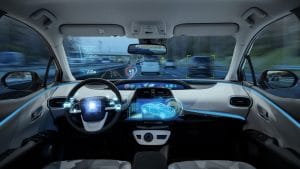Autonomous Vehicles: Will They Ever Be Safe Enough?
 Have there ever been times when, as a driver, you wish someone else could take the driving over for you? Maybe you would like to experience the feeling of going into autopilot whenever you have been traveling for too long on the road. Essentially, that is the premise of an autonomous vehicle.
Have there ever been times when, as a driver, you wish someone else could take the driving over for you? Maybe you would like to experience the feeling of going into autopilot whenever you have been traveling for too long on the road. Essentially, that is the premise of an autonomous vehicle.
A fully autonomous vehicle is a vehicle that is capable of driving itself; it has the ability to sense its environment and operate without any human involvement. An autonomous vehicle is a perfect combination of traveling anywhere that a traditional vehicle can go while performing all of the operations that a human driver can perform.
The German auto manufacturer Mercedes-Benz recently became the first automobile manufacturing company to receive the internationally valid regulatory approval of producing vehicles capable of Level 3 autonomous driving. After the opening of the Road Traffic Act for Level 3 systems in 2017, Germany was the first country to create a legal basis for the use of Level 3 driving aids.
What are some of the features of a Level 3 autonomous vehicle?
A Level 3 autonomous vehicle has the ability to react to its environment and make decisions without forcing the driver to take control. The Mercedes-Benz’s updated Drive Pilot system has the ability to take over all driving responsibilities while the vehicle is driving at a speed of 37 miles per hour.
Once the driver activates Drive Pilot through a pair of buttons above the steering wheel thumb rests, the system maintains the driving speed and following distance while independently executing braking and evasive maneuvers. The system also incorporates existing sensors and additional sensors like lidar, microphones, and an additional camera in the rear window. Drive Pilot also incorporates additional features such as road geometry, traffic signs, route profiles, and traffic events from a high-precision positioning system and a digital HD map to help drive the vehicle.
How do autonomous vehicles operate?
Autonomous vehicles incorporate sensors, complex algorithms, machine learning systems, and powerful processors to produce software. By placing various sensors in different parts of the vehicle, autonomous vehicles create and maintain a map of their surroundings. For example, some vehicles may use radar sensors to monitor the position of oncoming vehicles. Video cameras can be used to detect traffic lights, read road signs, locate other vehicles, and remain aware of any pedestrians. There are even ultrasonic sensors located in the wheels that help to detect curbs and other vehicles while parking.
What are some of the benefits of fully autonomous vehicles?
Some of the benefits of autonomous vehicles include an increase in quality of life and convenience for drivers. Elderly drivers who do not want to lose their independence could love the use of autonomous vehicles. Because autonomous vehicles can operate whether a human being is in the vehicle or not, you can send your vehicle to make deliveries or pick up passengers, which may be a boon for smaller companies.
Drivers also have additional options of watching a movie, falling asleep or even talking on the phone with friends without worrying about being pulled over. In addition to extra time to engage in additional activities for drivers, traffic congestion and transportation costs will be significantly reduced.
What are some of the challenges of autonomous vehicles?
With so many benefits that an autonomous vehicle can provide, how many potential problems can autonomous vehicles cause? Unfortunately, in the answer is many – at least, so far. One of the challenges associated with autonomous vehicles is the issue of technological malfunctions. Autonomous vehicles use sensors known as lidar sensors (light detection and ranging) to measure distances, detect road edges, and identify lane markers. If multiple autonomous vehicles travel on the same road, will there be an issue with the lidar signals? Is the technology at risk of malfunctioning or interfering with one another?
Another challenge with how an autonomous vehicle will operate in specific weather conditions. If two inches of snowfall on the ground and cover the lane markers, how will the autonomous vehicle respond? Another challenge is determining the liability of a traffic accident. Even with the sensors and technologies, autonomous vehicles are still able to become involved in traffic accidents; and when they do, who should be held liable? Should the manufacturer of the vehicle be held liable for any injuries sustained in a traffic accident, or should the human being be held liable? If there are no human beings located in one or either vehicle, should liability even be considered?
Until these questions are answered, we have serious concerns about self-driving cars. While safety features like back-up cameras and lane assist offer a number of benefits, truly autonomous vehicles simply don’t seem safe enough yet. And this could potentially be a real problem, because these autonomous vehicles are already in Phoenix. Waymo One is a fully-autonomous taxi service, and we see their vehicles all around town. Autonomous trucks are also being tested in Arizona, which means the concerns we have must be addressed soon and in full because self-driving cars are already on our roads.
The National Highway Traffic Safety Administration (NHTSA) and autonomous vehicles
While the NHTSA is in general supportive of the use of autonomous vehicles, the organization has issued a final set of specific rules that will determine how autonomous vehicles will perform in the future. These guidelines will also help to shape how the entire vehicle industry will function for years to come.
The United States government has updated its antiquated regulations of self-driving vehicles to include vehicles without pedals, seats, or even steering wheels. Another regulation includes the requirement of the autonomous vehicle to protect any passengers in the same manner that every other vehicle can.
Find out why other personal injury lawyers in Arizona and across the country have relied on us for years to handle the most complex cases. Product defect cases are handled on a contingency basis. You pay nothing unless we secure a settlement or verdict on your behalf. There is no reason not to call us today. Call Plattner Verderame Arizona Injury Lawyers at 602-266-2002, or complete our contact form to discuss your auto defect claim with a knowledgeable Phoenix injury lawyer. We maintain an additional office in Tempe.

Nick is a member of the State Bar of Arizona, the Arizona Association for Justice (formerly the Arizona Trial Lawyers Association) and the American Association for Justice (AAJ). His practice focus is wrongful death, product liability, personal injury, and he has published articles on the topic of sports-related concussions for publication nationally.
Read more about Nick Verderame
